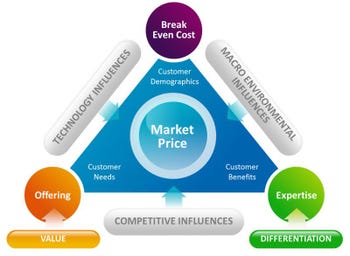Managed Services Pricing: Keys to Formulating Optimal Pricing For Your BusinessManaged Services Pricing: Keys to Formulating Optimal Pricing For Your Business
Pricing is a big decision, and it’s one that’s not very clear cut. While everyone is looking for a simple answer, the proverbial silver bullet, one doesn’t exist. But, there are several key considerations to help you find the right pricing for your businesses. Here's a deep dive.
August 9, 2013

By CA Technologies Guest Blog 1
 Pricing is a big decision, and it’s one that’s not very clear cut. While everyone is looking for a simple answer, the proverbial silver bullet, one doesn’t exist. Instead, there are several key considerations that decision makers must take into account in determining the right pricing for their businesses.
Pricing is a big decision, and it’s one that’s not very clear cut. While everyone is looking for a simple answer, the proverbial silver bullet, one doesn’t exist. Instead, there are several key considerations that decision makers must take into account in determining the right pricing for their businesses.
To date, many decision makers have lacked an effective model that could help guide them through the process of determining an appropriate market price. In this brief, we’ll share a comprehensive visual model for factoring in all the key elements required to establish a sound pricing approach, one that can inform the evolution of your pricing decisions. Then we’ll offer some background on each individual factor.
Internal considerations
Break-even cost
First, you have to start with an understanding of the costs associated with delivering the service. This is critical as it’s the only way to know that your pricing won’t set you up to lose money. In calculating break-even cost, there are a few key elements to include:
Operating and capital expenses. Headcount costs, both of service delivery and non-service delivery staff. You need to calculate the so-called “burdened” rate of staff, which factors the expense associated with employees beyond salary, including payroll taxes, health insurance, training, vacation and sick leave.
Add-ons to your product or service delivery, for example, if you install anti-virus software as part of your managed service offering.
Onboarding costs, including device onboarding costs, direct expenses and acquisition costs.
Costs of sale, specifically including the time associated with closing business, which often amounts to more time and money than executives may think.
It is important to recognize that establishing an accurate break-even cost is critical not only in setting pricing, but in identifying areas for optimization. Once a break-even cost is established, you can examine ways to drive that number down. The more that cost is reduced, the more profitability your business will generate on a per-service basis.
Expertise and differentiation
It’s important to examine the levels of expertise your team brings to customers, and factor that level of expertise into your pricing. One useful analogy is to think about this expertise in terms of the spectrum of doctors that work in the healthcare industry. As a general practitioner, you’d tend to charge less on an hourly basis than a highly specialized surgeon. Similarly, there are a range of service providers your customers may work with, and it’s important to assess how the expertise of your team compares. This expertise can be the result of a focus on a specific service, industry or technology. The degree of expertise of your team ties directly to how your business is differentiated.
Offering and value
Your pricing has to be based on an assessment of your offerings and the value customers realize from them. One factor to consider is the level of commoditization associated with the offering. Is it a broadly available offering? Depending on the answer, the value the customer derives and the market pricing would vary substantially. For example, if a service provider is offering an infrastructure management service for storage and networks, that offering would be priced much lower than a service relating to a highly specialized line-of-business application. Other variables include the customer’s perception of the value derived and the market demand for the offering. It is important to recognize that these factors will change over time. As offerings grow more complex or sophisticated, pricing should evolve to reflect that.
Customer attributes
The customers your business targets will also play a significant role in the pricing that you set. Following are the key customer attributes to assess:
Customer demographics. In setting pricing, it’s critical to factor in customer demographics, which can encompass several key attributes of target accounts, including their size, their region and how they value and approach IT. Price sensitivity can change by region, state and even city—and it is highly driven by individual expectations and perspectives. Establishing a solid grasp of the makeup of the customer base helps you better understand what a customer might be willing to pay for a given service.
Customer needs. In evaluating needs, think about how important of a need your organization is addressing, and how easy it would be for another vendor to replicate or replace the offering. Scale is another important factor. For example, providing remote management and monitoring of ATMs for a Fortune 100 banking institution would be very different than servicing the POS devices of a retailer with six regional outlets.
Customer benefits. How do your offerings help your customers? How strategic are those benefits? Are you providing a level of expertise that allows your customer to avoid hiring specialized resources that may be hard to find and very costly? The nature of benefits provided will also play a significant role. For example, if you’re offering security services that help clients reduce risk and better manage regulatory compliance issues, those are strategic benefits that can command a higher price point, particularly if your customers don’t possess deep security expertise internally.
External influences
External trends and developments can have a significant role to play in pricing. Plus, you can identify new opportunities when you consider how changes might impact customers and the services you can provide them. Following are the core external influences to evaluate:
Technology influences. The technological landscape continues to evolve, which has fundamental implications for MSPs and their pricing. For example, the cloud has altered the market landscape, which shapes both how you deliver a service and the cost to do so. The cloud, mobile devices and big data all create opportunities and challenges for providers. The goal is to view these as inputs and influences to evolve your offerings and pricing so they continue to be optimally aligned with customer expectations.
Macro environmental influences. This category can include a broad range of factors that can influence the services provider’s pricing, markets and services, but that are sometimes less visible at their onset. For example, healthcare reform in the United States has significantly changed reporting and regulatory requirements for all healthcare providers. Many small and mid-sized health care practices are ill equipped to contend with these new, often confusing requirements. This creates a market opportunity for service providers that can help customers navigate this reform and address its new requirements.
Competitive influences. For just about every MSP, there’s no shortage of competitors that are working to enter or take over existing accounts. It’s important to assess, and stay current on, the competitive landscape, and understand how changes in competitive players, strategies, offerings and prices may affect your business and the prices it can command. Understanding your position in the market and how to stay in front of the competition will have a direct bearing on the market price you charge, and, more importantly, on the price your customers are willing to pay.
Conclusion
Make no mistake, pricing takes some effort, and that effort must be sustained over time. On the other hand, leaving these important decisions to guesswork can expose your business to some significant risk, including lost revenues and business. By leveraging the model outlined above, your leadership team can address the key considerations required, so it can establish a pricing strategy that maximizes your business’ chances for growth and profitability.
 Greg Donovan is vice president of service providers at CA Technologies.
Greg Donovan is vice president of service providers at CA Technologies.
You May Also Like
